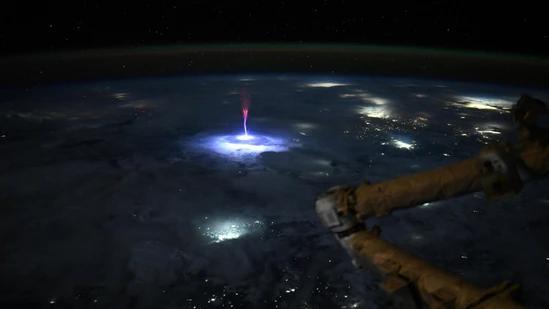
NASA Astronaut Captures Rare “Sprite” Lightning Over US & Mexico
In a thrilling discovery, NASA astronaut Nichole Ayers has captured a rare and breathtaking sight of “sprite” lightning over the United States and Mexico. The stunning image was taken from the International Space Station while Ayers was orbiting above the two countries. The sprite, a type of Transient Luminous Event (TLE), is a brief burst of light that occurs above thunderstorms.
Ayers, who is a member of NASA’s 64th class of astronauts, shared the remarkable photo on social media, showcasing the rare atmospheric phenomenon. The image has since gone viral, captivating the attention of scientists, astronomy enthusiasts, and the general public alike.
Sprites are relatively rare and elusive, making Ayers’ capture all the more significant. These brief bursts of light occur when a thunderstorm is intense enough to produce a massive electrical discharge, known as a leader, which travels from the cloud to the ground. When the leader interacts with the Earth’s magnetic field, it creates a spectacular display of light in the form of a sprite.
Ayers’ photo is a testament to the incredible capabilities of the International Space Station, which provides a unique platform for astronauts to conduct scientific research and capture breathtaking images of our planet. As Ayers herself noted, “Scientists can use these types of photos to better understand the relationship of TLE to thunderstorms.”
The International Space Station orbits the Earth at an altitude of around 250 miles (400 kilometers), allowing astronauts like Ayers to capture stunning images of atmospheric phenomena like sprites. The station’s position also enables scientists to study the Earth’s magnetic field, atmosphere, and oceans in unprecedented detail.
Sprites are just one type of TLE, which also includes other rare and fascinating atmospheric phenomena like blue jets and gigantic jets. These events are often associated with intense thunderstorms and can provide valuable insights into the complex interactions between the Earth’s atmosphere, magnetosphere, and ionosphere.
Ayers’ capture of the sprite is not only a remarkable achievement but also a significant contribution to our understanding of these complex atmospheric phenomena. The image is a testament to the incredible capabilities of NASA’s astronauts and the scientific community, who continue to push the boundaries of human knowledge and exploration.
As scientists continue to study Ayers’ photo and other images of sprites, they may uncover new insights into the intricacies of the Earth’s atmosphere and the complex interactions that govern our planet’s weather patterns. The discovery of sprites and other TLEs has significant implications for our understanding of thunderstorms, climate modeling, and even space weather forecasting.
In conclusion, NASA astronaut Nichole Ayers’ capture of the rare “sprite” lightning phenomenon is a remarkable achievement that has sparked widespread interest and excitement among scientists and the general public alike. The stunning image is a testament to the incredible capabilities of the International Space Station and the scientific community, and it provides a unique opportunity for scientists to better understand the complex relationships between the Earth’s atmosphere, magnetosphere, and ionosphere.






